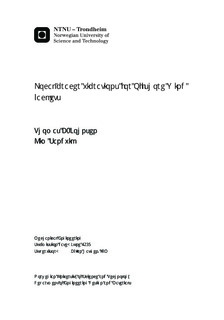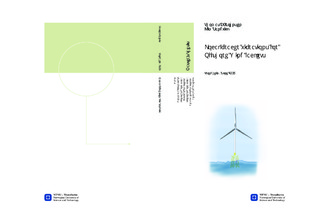| dc.description.abstract | During the course of this master project, the candidates have worked with FEA of local vibrations occurring in bracers on offshore windturbine jacket. These vibrations arise as a dynamic response from wind-, wave-, and windturbine- loads. The predicted vibrations can vary depending on which analysis method is being used. The methods in question are fully coupled- and sequentially coupled analysis. The given task provided by TDA included a literature study, a study of the phenomenon in question and a recommendation of how to handle the problem.
It was necessary to be able to run both fully coupled analysis and sequentially coupled analysis to be able to study the phenomenon. The FEA codes USFOS and FEDEM was chosen for the analyses in the project. The fully coupled analysis were performed in FEDEM, while the sequentially coupled analysis were performed using a combination of both FEDEM and USFOS.
To be able to run a sequentially coupled analysis, using a combination of FEDEM and USFOS, the general properties of the jacket structure had to be defined in FEDEM without including the actual jacket structure in the FEA. This was solved by replacing the jacket structure by a full spring connected to ground. The properties of the spring included the full stiffness matrix, the diagonal damping matrix and the diagonal mass matrix. These matrices were extracted analytically from analyses made in USFOS that captured the response of the jacket structure from static and dynamic load cases. Generating these matrices was a complex and time consuming task, and created a need for scripts that could run and extract information from a large number of analyses.
Once the fully coupled- and sequential analyses were done, comparisons could be made. Prior to viewing the results, the assumption was that the sequentially coupled analysis would predict more damage than the fully coupled analysis. The results showed that the sequentially coupled analysis predicted more damage than fully coupled analysis, but the differences were extreme, and the explanation to this had to be found. After debugging input files, output files, and scripts involved in the results extraction without finding any errors, the cause would have to lie within the FEM analysis. It was reasonable to believe that the error was within the sequentially coupled analysis due to the prediction of very short lifetime. The debugging was done to find which factors contributed to the error in question. The factor contributing most to the errors was found likely to be values in the K, C and M matrixes affecting the rotational degree of freedom in z-direction. This results in severe twisting of the offshore wind turbine, contributing to higher axial forces in the bracers, again affecting the accumulated damage.
This report shows how important and how difficult it is to get all parameters right when doing a sequentially coupled analysis, indicating that it is a vulnerable method when generating the needed K, C and M matrixes analytically. | |

